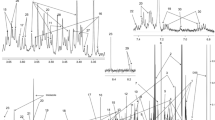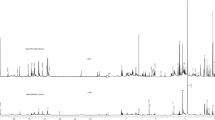Abstract
A metabolomic approach was used to analyze endogenous metabolites and to correlate with a specific biological state. The analysis of salivary metabolites is a growing area of investigation with potential for basic and clinical applications. Analyses of children’s saliva in different dentitions and with or without caries could potentially reveal a specific profile related to oral disease risk. Nuclear Magnetic Resonance (NMR) is well suited for mixture analysis followed by Principal Component Analysis combined with Linear Regression (PCA-LR) statistics and was used to identify differences in the salivary metabolites. The classificatory analysis was performed using PCA-LR based on 1,000 cross-validation bootstrap runs from both classifiers in order to increase the data information from a small sample size. The PCA-LR presented a statistically good classificatory performance for children with and without caries with an accuracy of 90.11 % (P < 0.001), 89.61 % sensitivity (P < 0.001), and 90.82 % specificity (P < 0.001). Children with caries lesions presented higher levels of several metabolites, including lactate, fatty acid, acetate and n-butyrate. Saliva from subjects with different dentition stages was also analyzed. Although the salivary samples were poorly classified, permanent dentition presented increased levels of acetate, saccharides and propionate. The NMR data and PCA-LR were able to classify saliva from children with or without caries, with performance indexes comparable to the partial least-squares regression discriminant analysis (PLS-DA) results also performed. Our data also showed similar salivary metabolite profiles for healthy subjects despite the differences in their oral hygiene habits, socioeconomic status and food intake.





Similar content being viewed by others
References
Al-Tarawneh, S. K., Border, M. B., Dibble, C. F., & Bencharit, S. (2011). Defining salivary biomarkers using mass spectrometry-based proteomics: A systematic review. OMICS: A Journal of Integrative Biology, 15(6), 353–361.
Bereton, R. G. (2006). Consequences of sample size, variable selection, and model validation and optimisation, for predicting classification ability from analytical data. Trac-Trends in Analytical Chemistry, 25(11), 1103–1111.
Bergandi, L., Defabianis, P., Re, F., Preti, G., Aldieri, E., Garetto, S., et al. (2007). Absence of soluble CD14 in saliva of young patients with dental caries. European Journal of Oral Sciences, 115(2), 93–96.
Bertram, H. C., Eggers, N., & Eller, N. (2009). Potential of human saliva for nuclear magnetic resonance-based metabolomics and for health-related biomarker identification. Analytical Chemistry, 81(21), 9188–9193.
Bollard, M. E., Stanley, E. G., Lindon, J. C., Nicholson, J. K., & Holmes, E. (2005). NMR-based metabonomic approaches for evaluating physiological influences on biofluid composition. NMR in Biomedicine, 18(3), 143–162.
Di Luigi, L., Baldari, C., Gallotta, M. C., Perroni, F., Romanelli, F., Lenzi, A., et al. (2006). Salivary steroids at rest and after a training load in young male athletes: Relationship with chronological age and pubertal development. International Journal of Sports Medicine, 27(9), 709–717.
Favretto, D., Cosmi, E., Ragazzi, E., Visentin, S., Tucci, M., Fais, P., et al. (2012). Cord blood metabolomic profiling in intrauterine growth restriction. Analytical and Bioanalytical Chemistry, 402(3), 1109–1121.
Goodacre, R., Vaidyanathan, S., Dunn, W. B., Harrigan, G. G., & Kell, D. B. (2004). Metabolomics by numbers: Acquiring and understanding global metabolite data. Trends in Biotechnology, 22(5), 245–252.
Grootveld, M., & Silwood, C. J. (2005). 1H NMR analysis as a diagnostic probe for human saliva. Biochemical and Biophysical Research Communications, 329(1), 1–5.
Hardt, M., Thomas, L. R., Dixon, S. E., Newport, G., Agabian, N., Prakobphol, A., et al. (2005). Toward defining the human parotid gland salivary proteome and peptidome: Identification and characterization using 2D SDS-PAGE, ultrafiltration, HPLC, and mass spectrometry. Biochemistry, 44(8), 2885–2899.
Jolliffe, I. T. (2002). Principal component analysis (2nd ed.). New York: Springer.
Kochhar, S., Jacobs, D. M., Ramadan, Z., Berruex, F., Fuerholz, A., & Fay, L. B. (2006). Probing gender-specific metabolism differences in humans by nuclear magnetic resonance-based metabonomics. Analytical Biochemistry, 352(2), 274–281.
Kuroda, H., Ogawa, N., Yamawaki, Y., Nukina, I., Ofuji, T., Yamamoto, M., et al. (1982). Cerebrospinal fluid GABA levels in various neurological and psychiatric diseases. Journal of Neurology, Neurosurgery and Psychiatry, 45(3), 257–260.
Lindon, J. C., Holmes, E., & Nicholson, J. K. (2001). Pattern recognition methods and applications in biomedical magnetic resonance. Progress in NMR Spectroscopy, 39(1), 1–10.
Liu, L., Aa, J., Wang, G., Yan, B., Zhang, Y., Wang, X., et al. (2010). Differences in metabolite profile between blood plasma and serum. Analytical Biochemistry, 406(2), 105–112.
Madsen, R., Lundstedt, T., & Trygg, J. (2010). Chemometrics in metabolomics—a review in human disease diagnosis. Analytica Chimica Acta, 659(1–2), 23–33.
Martin, F. P., Rezzi, S., Pere-Trepat, E., Kamlage, B., Collino, S., Leibold, E., et al. (2009). Metabolic effects of dark chocolate consumption on energy, gut microbiota, and stress-related metabolism in free-living subjects. Journal of Proteome Research, 8(12), 5568–5579.
Neyraud E, Tremblay-Franco M, Gregoire S, Berdeaux O, Canlet C. (2012). Relationships between the metabolome and the fatty acid composition of human saliva; effects of stimulation. Metabolomics. doi:10.1007/s11306-012-0440-6.
Pfaffe, T., Cooper-White, J., Beyerlein, P., Kostner, K., & Punyadeera, C. (2011). Diagnostic potential of saliva: current state and future applications. Clinical Chemistry, 57(5), 675–687.
Piotto, M., Saudek, V., & Sklenar, V. (1992). Gradient-tailored excitation for single-quantum NMR spectroscopy of aqueous solutions. Journal of Biomolecular NMR, 2(6), 661–665.
Ramadan, Z., Jacobs, D., Grigorov, M., & Kochhar, S. (2006). Metabolic profiling using principal component analysis, discriminant partial least squares, and genetic algorithms. Talanta, 68(5), 1683–1691.
Ryan, D., Robards, K., Prenzler, P. D., & Kendall, M. (2011). Recent and potential developments in the analysis of urine: A review. Analytica Chimica Acta, 684(1–2), 8–20.
Sahiner, B., Chan, H. P., & Hadjiiski, L. (2008). Classifier performance prediction for computer-aided diagnosis using a limited dataset. Medical Physics, 35(4), 1559–1570.
Schumacher, M., Robner, R., & Wemer, V. (1996). Neural networks and logistic regression part I. Computational Statistics and Data Analysis, 21(1), 661–682.
Silwood, C. J., Lynch, E., Claxson, A. W., & Grootveld, M. C. (2002). 1H and (13)C NMR spectroscopic analysis of human saliva. Journal of Dental Research, 81(6), 422–427.
Silwood, C. J., Lynch, E. J., Seddon, S., Sheerin, A., Claxson, A. W., & Grootveld, M. C. (1999). 1H-NMR analysis of microbial-derived organic acids in primary root carious lesions and saliva. NMR in Biomedicine, 12(6), 345–356.
Slomiany, B. L., Murty, V. L., Mandel, I. D., Zalesna, G., & Slomiany, A. (1989). Physico-chemical characteristics of mucus glycoproteins and lipids of the human oral mucosal mucus coat in relation to caries susceptibility. Archives of Oral Biology, 34(4), 229–237.
Streckfus, C. F., Bigler, L. R., & Zwick, M. (2006). The use of surface-enhanced laser desorption/ionization time-of-flight mass spectrometry to detect putative breast cancer markers in saliva: A feasibility study. Journal of Oral Pathology and Medicine, 35(5), 292–300.
Sugimoto, M., Wong, D. T., Hirayama, A., Soga, T., & Tomita, M. (2010). Capillary electrophoresis mass spectrometry-based saliva metabolomics identified oral, breast and pancreatic cancer-specific profiles. Metabolomics, 6(1), 78–95.
Takahashi, N., Washio, J., & Mayanagi, G. (2010). Metabolomics of supragingival plaque and oral bacteria. Journal of Dental Research, 89(12), 1383–1388.
Takeda, I., Stretch, C., Barnaby, P., Bhatnager, K., Rankin, K., Fu, H., et al. (2009). Understanding the human salivary metabolome. NMR in Biomedicine, 22(6), 577–584.
Tiziani, S., Lopes, V., & Gunther, U. L. (2009). Early stage diagnosis of oral cancer using 1H NMR-based metabolomics. Neoplasia (New york, N.Y), 11(3), 269–276. 264p is following 269.
Tomita, Y., Miyake, N., & Yamanaka, S. (2008). Lipids in human parotid saliva with regard to caries experience. Journal of Oleo Science, 57(2), 115–121.
van Houte, J. (1994). Role of micro-organisms in caries etiology. Journal of Dental Research, 73(3), 672–681.
Walsh, M. C., Brennan, L., Malthouse, J. P., Roche, H. M., & Gibney, M. J. (2006). Effect of acute dietary standardization on the urinary, plasma, and salivary metabolomic profiles of healthy humans. The American Journal of Clinical Nutrition, 84(3), 531–539.
Wei, J., Xie, G., Zhou, Z., Shi, P., Qiu, Y., Zheng, X., et al. (2011). Salivary metabolite signatures of oral cancer and leukoplakia. International Journal of Cancer, 129(9), 2207–2217.
Westerhuis, J. A., Hoefsloot, H. C. J., Smit, S., Vis, D. J., Smilde, A. K., van Velzen, E. J. J., et al. (2008). Assessments of PLSDA cross validation. Metabolomics, 4(1), 81–89.
Wishart, D. S., Tzur, D., Knox, C., Eisner, R., Guo, A. C., Young, N., et al. (2007). HMDB: The human metabolome database. Nucleic acids research, 35(Database issue), D521–D526.
Zhang, A., Sun, H., Wang, P., Han, Y., & Wang, X. (2012). Recent and potential developments of biofluid analyses in metabolomics. Journal of Proteomics, 75(4), 1079–1088.
Acknowledgments
The authors acknowledge the financial support from the following agencies: National Institute of Science and Technology of Structural Biology and Bioimaging (INCT-INBEB), CNPq, FAPERJ, FINEP, and CAPES. We also acknowledge the Bruker (Bruker Biospin, Rheinstetten, Germany) for providing a demo license of AMIX program during the analysis of the data.
Conflict of interest
None.
Author information
Authors and Affiliations
Corresponding author
Electronic supplementary material
Below is the link to the electronic supplementary material.
Rights and permissions
About this article
Cite this article
Fidalgo, T.K.S., Freitas-Fernandes, L.B., Angeli, R. et al. Salivary metabolite signatures of children with and without dental caries lesions. Metabolomics 9, 657–666 (2013). https://doi.org/10.1007/s11306-012-0484-7
Received:
Accepted:
Published:
Issue Date:
DOI: https://doi.org/10.1007/s11306-012-0484-7




